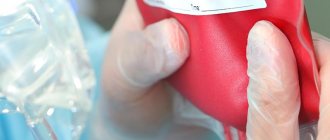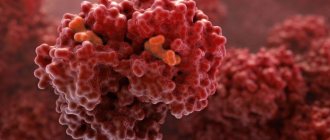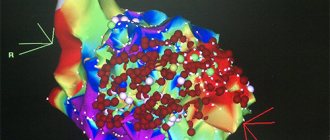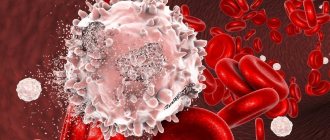Hepatitis C is a disease caused by an RNA virus. The virus can be transmitted through blood, through unsterile medical instruments, during organ and tissue transplantation, through sexual contact, from mother to child during pregnancy and childbirth. It multiplies in liver cells and causes the development of acute or chronic hepatitis. The hepatitis C virus has several genotypes; due to frequent mutations, it is resistant to human immune defense mechanisms.
Viral hepatitis C is most often asymptomatic. Only in 15% of cases of acute disease are nausea, signs of intoxication, lack of appetite observed, and jaundice is rare. A minority of patients experience hepatitis C as an acute disease and fully recover; the majority of those infected develop chronic hepatitis C. Long-term chronic disease can lead to cirrhosis or liver cancer.
At the start of the disease, antibodies to the components of the virus begin to form, first immunoglobulins M, later immunoglobulins G. Specific antibodies to the hepatitis C virus can be detected in the blood 3–8 weeks after the virus enters the body, but in some cases they may be absent for several months. In this case, infection can be confirmed by testing the blood for hepatitis C virus RNA. After infection in recovered patients, specific antibodies persist for many years with a gradually decreasing concentration and can be detected in low quantities throughout life. Antibodies to hepatitis C do not protect against re-infection when exposed to the virus again.
Those at risk for hepatitis C include doctors and nurses, people who use medical and cosmetic services, drug addicts, patients who have undergone blood transfusions or organ transplants, and children born to infected mothers who are carriers of the hepatitis C virus.
An analysis for total antibodies to the hepatitis C virus (HCV) allows you to identify specific immunoglobulins, the presence of which indicates a possible infection or a previous disease. The test is a screening test; it is mandatory to take it during hospitalization, before planned operations and during pregnancy.
Antibodies to hepatitis C virus (total)
Antibodies to the hepatitis C virus are normally absent in the serum. Total antibodies to the hepatitis C virus are antibodies of the IgM and IgG classes directed to the complex of structural and non-structural proteins of the hepatitis C virus. This study is a screening test to identify patients with VSH.
Total antibodies to the hepatitis C virus can be detected in the first 2 weeks of the disease, and their presence indicates possible infection with the virus or a previous infection. It is impossible to obtain an unambiguous answer based on the results of this test, since the test determines total IgM and IgG antibodies. If this is an early period of acute viral hepatitis C, then this is indicated by IgM antibodies, and if this is a period of convalescence or a condition after suffering from HCV, then this is indicated by IgG antibodies.
IgG antibodies to HCV can persist in the blood of convalescents for 8-10 years with a gradual decrease in their concentration. Late detection of antibodies is possible a year or more after infection. In chronic hepatitis C, total antibodies are constantly determined. Therefore, to clarify the timing of infection, it is necessary to separately determine IgM antibodies to HCV.
Evaluation of the study results
The result of the study is expressed qualitatively - positive or negative. A negative test result indicates the absence of total antibodies (JgM and JgG) to HCV in the blood serum. A positive result - the detection of total antibodies (JgM and JgG) to HCV indicates the initial stage of acute viral hepatitis C, the acute period of infection, the early stage of convalescence, previous viral hepatitis C or chronic viral hepatitis C.
However, the detection of total antibodies to HCV is not sufficient to make a diagnosis of HCV and requires confirmation to exclude a false-positive test result. Therefore, when a positive result of a screening test for total antibodies to HCV is obtained, a confirmatory test is performed in the laboratory. The final result of determining total antibodies to HCV is issued together with the result of the confirmatory test.
Preparation and delivery of blood tests for hepatitis C
The composition of the blood depends on many factors: the person’s condition; time of day; meals, etc. That is why preparation is necessary to obtain a reliable interpretation of a blood test for hepatitis C. Before donating blood, it is recommended:
- 2-3 days in advance, eliminate the consumption of alcohol, as well as fatty and fried foods;
- It is recommended to avoid stress and excessive physical activity during the day;
- You should refrain from eating any food for 8 hours before being tested for hepatitis C.
Experts also recommend stopping taking any medications. If this is not possible, your doctor should be notified.
Patients whose tests for hepatitis C have confirmed the presence of the disease should not despair. Modern medicine has means to combat the virus - drugs based on sofosbuvir, daclatasvir, velpatasvir and ledipasvir. The medicines have passed all the necessary stages of research and confirmed the effectiveness of antiviral therapy.
Antibodies to hepatitis C virus JgM
Antibodies to the hepatitis C virus JgM are normally absent in the serum. The presence of JgM class antibodies to HCV in the patient’s blood makes it possible to verify active infection. Antibodies of the JgM class can be detected not only in acute HCV, but also in chronic hepatitis C.
Antibodies of the JgM class to HCV appear in the patient’s blood 2 weeks after the development of the clinical picture of acute viral hepatitis C or exacerbation of chronic hepatitis and usually disappear after 4-6 months. A decrease in their level may indicate the effectiveness of drug therapy.
Polymerase chain reaction (PCR)
The next step after anti-HCV IgM and IgG is a polymerase chain reaction test. With its help, it is possible to detect the RNA of the virus in human blood, determine the degree of load and the genotype of the disease. There are several types of PCR tests for hepatitis C.
- Qualitative testing is used to identify the genetic material of the virus in a patient's blood. The test result for hepatitis C is indicated as “detected” or “not detected”. In the second case, the indicator may be false negative. This occurs in cases where too little time has passed since infection and the number of pathogens has not reached the level determined during testing.
- Quantitative analysis allows you to determine the concentration of the virus. This indicator plays a key role in developing a treatment regimen for HCV. The decoding of the hepatitis C PCR analysis is issued in a digital value: less than <1.5x10*3 IU/ml - the concentration has not reached the lower threshold; <4x10*6 IU/ml – a small amount indicating the onset of the disease; >4x10*6 IU/ml – high amount; >2x10*8 IU/ml – concentration above the linear limit.
In addition to qualitative and quantitative analysis for hepatitis C, genotyping of the disease is carried out. Knowing the genotype, it is possible to accurately predict the response of the virus to treatment with a particular drug and develop an optimal treatment regimen.
Detection of hepatitis C virus by PCR (qualitative)
The hepatitis C virus is normally absent in the blood. Unlike serological methods for diagnosing HCV, where antibodies to HCV are detected, PCR allows you to directly detect the presence of HCV RNA in the blood, both qualitatively and quantitatively. The detectable fragment in both is a conserved region of the hepatitis C genome.
The detection of only antibodies to HCV confirms only the fact of infection of the patient, but does not allow one to judge the activity of the infectious process (virus replication) or the prognosis of the disease. In addition, antibodies to the HS virus are found both in the blood of patients with acute and chronic hepatitis, and in those patients who were sick and recovered, and often antibodies in the blood appear only several months after the onset of the clinical picture of the disease, which makes diagnosis difficult. Detection of the virus in the blood using PCR is a more informative diagnostic method.
Qualitative detection of HCV by PCR in the blood indicates viremia, allows us to judge the reproduction of the virus in the body and is one of the criteria for the effectiveness of antiviral therapy.
The analytical sensitivity of the PCR method is at least 50-100 viral particles in 5 μl of DNA sample isolation; specificity is 98%. Detection of hepatitis C virus RNA using PCR in the early stages of the development of a viral infection (possibly as early as 1-2 weeks after infection) against the background of the complete absence of any serological markers can serve as the earliest evidence of infection.
However, isolated detection of hepatitis C virus RNA in the absence of any other serological markers cannot completely exclude a false-positive PCR result. In such cases, a comprehensive evaluation of clinical, biochemical and morphological studies and repeated repeated confirmation of the presence of infection by PCR is required.
According to WHO recommendations, to confirm the diagnosis of viral hepatitis C, triple detection of hepatitis C virus RNA in the patient’s blood is necessary.
- Detection of hepatitis C virus RNA by PCR is used for the following purposes:
- resolution of questionable results of serological studies;
- differentiation of hepatitis C from other forms of hepatitis;
- identification of the acute stage of the disease in comparison with previous infection or exposure; determining the stage of infection of newborns from mothers seropositive for the hepatitis C virus;
- monitoring the effectiveness of antiviral treatment.
What is hepatitis C?
The hepatitis C virus was discovered relatively recently. If left untreated, the disease can progress to liver cirrhosis or cancer. Until a certain time, it was widely believed that this was a death sentence. This is all due to the low medical literacy of the population, as well as the fact that for a very long time medications for this disease were very expensive and inaccessible to the average person. However, now the cost of treatment is also quite high. However, it is possible to recover now.
The incubation period is up to 60 days. The main difficulty in diagnosing hepatitis C at the first stage is that symptoms may be mild or completely absent. In addition, symptoms may masquerade as other diseases. In general, the disease in its early stages can manifest itself as follows:
- Increased body temperature.
- Aches in the joints.
- Heaviness in the stomach area.
- Painful sensations in the right hypochondrium.
- Fast fatiguability.
- Digestive disorders.
- Stool or urine that is too light.
- General weakness.
The peculiarity of the disease is that all these signs appear separately and from time to time and pass relatively quickly. Therefore, detection in the early stages is very difficult. Therefore, it is so important to determine the presence of antibodies to hepatitis in time.
Detection of hepatitis C virus by PCR (quantitative)
A quantitative method for determining the content of hepatitis C virus RNA in the blood provides important information about the intensity of the disease, the effectiveness of treatment, and the development of resistance to antiviral drugs. The analytical sensitivity of the method is from 5.102 copies/ml of viral particles in blood serum, specificity is 98%.
The level of viremia is assessed as follows: when the HCV RNA content is from 10^2 to 10^4 copies/ml – low; from 10^5 to 10^7 copies/ml – medium and above 10^8 copies/ml – high.
Quantitative determination of HCV RNA in blood serum by PCR is important for predicting the effectiveness of interferon-alpha treatment. It has been shown that individuals with a low level of viremia have the most favorable prognosis of the disease and the greatest likelihood of a positive response to antiviral therapy. With effective treatment, the level of viremia decreases.
Complexes with this research
Future dad Comprehensive examination to prepare a couple for conception 8,460 RUR Composition
Entry into IVF Examination when a woman enters the IVF procedure 23,020 RUR Composition
Male check-up No. 1 39 studies for annual preventive examination RUR 18,570 Composition
IN OTHER COMPLEXES
- Hospital complex 2,100 RUR
- Preparation for IVF for a man 6,060 RUR
- Pregnancy planning. Diagnosis of infections RUB 8,620
- Preparation for partner childbirth for a man RUB 3,680
- Male infertility. Extended examination RUB 29,030
How to reduce high viremia
After conducting an analysis for the quantitative determination of HCV and deciphering its results, the specialist develops treatment tactics:
- Direct-acting antiviral drugs
(“Maviret”, “Sofosbuvir”, “Daklatasvir”, “Vikeira Pak”, “Velpatasvir”, “Ledipasvir”, etc.). Medicines are effective, safe, have a small number of contraindications; - Combination “Interferon” + “Ribavirin”.
Today it is used quite rarely: its effectiveness is too low (if compared with the latest generation of medicines) and a large list of contraindications. However, if the patient cannot tolerate other antiviral drugs or has any restrictions, these drugs are prescribed to him; - Hepatoprotectors
(“Essentiale Forte”, “Hepa-Merz”, “Karsil”, “Legalon”, etc.). The drugs are prescribed to everyone who complains of liver problems. They should be taken for a long time until the liver recovers completely; - Multivitamin complexes.
These preparations contain B vitamins, antioxidants (vitamins A and E, ascorbic acid), basic macro- and microelements, and essential amino acids.
Properly selected complex therapy is one of the few ways to reduce the viral load. In addition, viremia can be quickly reduced with a strict diet. The patient should eat in accordance with table No. 5, if his condition is severe enough - with table No. 5a. Alcoholic drinks, drugs, and cigarettes are strictly prohibited.










